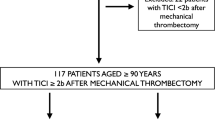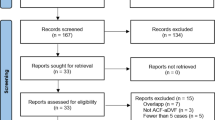Abstract
Objectives
To identify the incidence of thromboembolic complications based on magnetic resonance imaging (MRI) and to explore the potential risk factors for thromboembolism (TE) during the periprocedural period of elective coil embolization for unruptured intracranial aneurysms.
Methods
We retrospectively reviewed all aneurysm cases treated with coil insertion between January 2008 and March 2011. Two hundred eighty-two coiling procedures for unruptured aneurysms were included in this study. The patients’ demographic characteristics were documented and records reviewed for abnormalities in diffusion-weighted imaging (DWI) seen on post-procedure MRI, intraoperative thrombus formation, and clinical signs of stroke.
Results
Overall, there were 87 (30.9 %) procedure-related complications in 282 aneurysms treated: 2 (0.7 %) procedural ruptures, 5 (1.8 %) symptomatic infarctions, and 80 (28.3 %) asymptomatic infarctions. Thromboembolic events during the procedure were observed more often in the the hyperlipidemia group (32/71 aneurysms, 45.1 %) than in the normal lipid profile group (39/196 aneurysms, 25.6 %; p = 0.002; chi-squre test). The coiling technique and size of the aneurysm were also associated with TE (p < 0.001 and p = 0.004).
Conclusion
Hyperlipidemia seems to be associated with a significant increase in the rate of thromboembolic events. In preventive procedures, modifiable risk factors should be managed to reduce complications. Although permanent deficits are rare, the high rate of thromboembolic events suggests that improvements in the technique, such as the addition of antiplatelet agents and the development of new embolic materials, are necessary.

Similar content being viewed by others
References
Altay T, Kang HI, Woo HH, Masaryk TJ, Rasmussen PA, Fiorella DJ, Moskowitz SI (2011) Thromboembolic events associated with endovascular treatment of cerebral aneurysms. J Neurointerv Surg 3:147–150
Bradac GB, Bergui M, Stura G, Fontanella M, Daniele D, Gozzoli L, Berardino M, Ducati A (2007) Periprocedural morbidity and mortality by endovascular treatment of cerebral aneurysms with GDC: a retrospective 12-year experience of a single center. Neurosurg Rev 30:117–125, discussion 125–116
Brooks NP, Turk AS, Niemann DB, Aagaard-Kienitz B, Pulfer K, Cook T (2008) Frequency of thromboembolic events associated with endovascular aneurysm treatment: retrospective case series. J Neurosurg 108:1095–1100
Burns JD, Brown RD Jr (2009) Treatment of unruptured intracranial aneurysms: surgery, coiling, or nothing? Curr Neurol Neurosci Rep 9:6–12
Cronqvist M, Wirestam R, Ramgren B, Brandt L, Nilsson O, Saveland H, Holtas S, Larsson EM (2005) Diffusion and perfusion MRI in patients with ruptured and unruptured intracranial aneurysms treated by endovascular coiling: complications, procedural results, MR findings and clinical outcome. Neuroradiology 47:855–873
de Groot JC, de Leeuw FE, Oudkerk M, van Gijn J, Hofman A, Jolles J, Breteler MM (2000) Cerebral white matter lesions and cognitive function: the Rotterdam Scan Study. Ann Neurol 47:145–151
Goldstein LB, Bushnell CD, Adams RJ, Appel LJ, Braun LT, Chaturvedi S, Creager MA, Culebras A, Eckel RH, Hart RG, Hinchey JA, Howard VJ, Jauch EC, Levine SR, Meschia JF, Moore WS, Nixon JV, Pearson TA (2011) Guidelines for the primary prevention of stroke: a guideline for healthcare professionals from the American Heart Association/American Stroke Association. Stroke 42:517–584
Heart Protection Study Collaborative Group (2002) MRC/BHF Heart Protection Study of cholesterol lowering with simvastatin in 20,536 high-risk individuals: a randomised placebo-controlled trial. Lancet 360:7–22
Hwang G, Jung C, Park SQ, Kang HS, Lee SH, Oh CW, Chung YS, Han MH, Kwon OK (2010) Thromboembolic complications of elective coil embolization of unruptured aneurysms: the effect of oral antiplatelet preparation on periprocedural thromboembolic complication. Neurosurgery 67:743–748, discussion 748
Kim JE, Lim DJ, Hong CK, Joo SP, Yoon SM, Kim BT (2010) Treatment of unruptured intracranial aneurysms in South Korea in 2006: a nationwide multicenter survey from the Korean Society of Cerebrovascular Surgery. J Korean Neurosurg Soc 47:112–118
Morita A, Kirino T, Hashi K, Aoki N, Fukuhara S, Hashimoto N, Nakayama T, Sakai M, Teramoto A, Tominari S, Yoshimoto T (2012) The natural course of unruptured cerebral aneurysms in a Japanese cohort. N Engl J Med 366:2474–2482
Nissen SE, Nicholls SJ, Sipahi I, Libby P, Raichlen JS, Ballantyne CM, Davignon J, Erbel R, Fruchart JC, Tardif JC, Schoenhagen P, Crowe T, Cain V, Wolski K, Goormastic M, Tuzcu EM (2006) Effect of very high-intensity statin therapy on regression of coronary atherosclerosis: the ASTEROID trial. JAMA 295:1556–1565
Pierot L, Spelle L, Vitry F (2008) Immediate clinical outcome of patients harboring unruptured intracranial aneurysms treated by endovascular approach: results of the ATENA study. Stroke 39:2497–2504
Ries T, Buhk JH, Kucinski T, Goebell E, Grzyska U, Zeumer H, Fiehler J (2006) Intravenous administration of acetylsalicylic acid during endovascular treatment of cerebral aneurysms reduces the rate of thromboembolic events. Stroke 37:1816–1821
Sierra C, De La Sierra A, Salamero M, Sobrino J, Gomez-Angelats E, Coca A (2004) Silent cerebral white matter lesions and cognitive function in middle-aged essential hypertensive patients. Am J Hypertens 17:529–534
Singh V, Gress DR, Higashida RT, Dowd CF, Halbach VV, Johnston SC (2002) The learning curve for coil embolization of unruptured intracranial aneurysms. AJNR Am J Neuroradiol 23:768–771
Sirimarco G, Deplanque D, Lavallee PC, Labreuche J, Meseguer E, Cabrejo L, Guidoux C, Olivot JM, Abboud H, Lapergue B, Klein IF, Mazighi M, Touboul PJ, Bruckert E, Amarenco P (2011) Atherogenic dyslipidemia in patients with transient ischemic attack. Stroke 42:2131–2137
Soeda A, Sakai N, Sakai H, Iihara K, Yamada N, Imakita S, Nagata I (2003) Thromboembolic events associated with Guglielmi detachable coil embolization of asymptomatic cerebral aneurysms: evaluation of 66 consecutive cases with use of diffusion-weighted MR imaging. AJNR Am J Neuroradiol 24:127–132
Sonobe M, Yamazaki T, Yonekura M, Kikuchi H (2010) Small unruptured intracranial aneurysm verification study: SUAVe study, Japan. Stroke 41:1969–1977
Spiotta AM, Bhalla T, Hussain MS, Sivapatham T, Batra A, Hui F, Rasmussen PA, Moskowitz SI (2011) An analysis of inflation times during balloon-assisted aneurysm coil embolization and ischemic complications. Stroke 42:1051–1055
Takao H, Nojo T (2007) Treatment of unruptured intracranial aneurysms: decision and cost-effectiveness analysis. Radiology 244:755–766
Wiebers DO, Whisnant JP, Huston J 3rd, Meissner I, Brown RD Jr, Piepgras DG, Forbes GS, Thielen K, Nichols D, O’Fallon WM, Peacock J, Jaeger L, Kassell NF, Kongable-Beckman GL, Torner JC (2003) Unruptured intracranial aneurysms: natural history, clinical outcome, and risks of surgical and endovascular treatment. Lancet 362:103–110
Workman MJ, Cloft HJ, Tong FC, Dion JE, Jensen ME, Marx WF, Kallmes DF (2002) Thrombus formation at the neck of cerebral aneurysms during treatment with Guglielmi detachable coils. AJNR Am J Neuroradiol 23:1568–1576
Yamada NK, Cross DT 3rd, Pilgram TK, Moran CJ, Derdeyn CP, Dacey RG Jr (2007) Effect of antiplatelet therapy on thromboembolic complications of elective coil embolization of cerebral aneurysms. AJNR Am J Neuroradiol 28:1778–1782
Conflicts of interest
None.
Author information
Authors and Affiliations
Corresponding author
Rights and permissions
About this article
Cite this article
Jo, K.I., Yeon, J.Y., Kim, K.H. et al. Predictors of thromboembolism during coil embolization in patients with unruptured intracranial aneurysm. Acta Neurochir 155, 1101–1106 (2013). https://doi.org/10.1007/s00701-013-1706-0
Received:
Accepted:
Published:
Issue Date:
DOI: https://doi.org/10.1007/s00701-013-1706-0




